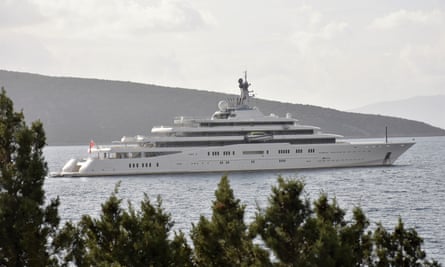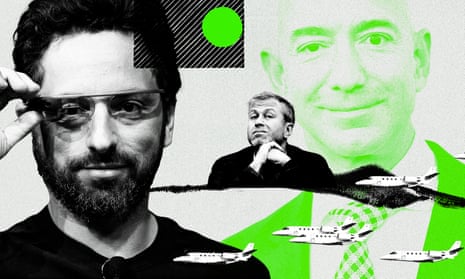Twelve of the world’s wealthiest billionaires produce more greenhouse gas emissions from their yachts, private jets, mansions and financial investments than the annual energy emissions of 2m homes, research shared exclusively with the Guardian reveals.
The tycoons include the Amazon boss, Jeff Bezos, the Russian oligarch Roman Abramovich, the tech billionaires Bill Gates, Larry Page and Michael Dell, the inventor and social media company owner Elon Musk and the Mexican business magnate Carlos Slim.
Analysis by Oxfam and US researchers of their luxury purchases, which include superyachts, private jets, cars, helicopters and palatial mansions, combined with the impact of their financial investments and shareholdings reveals that they account for almost 17m tonnes of CO2 and equivalent greenhouse gas emissions annually.
This is the same as the CO2 and equivalent emissions from powering 2.1m homes or the emissions from 4.6 coal-fired power plants over a year, according to conversion data from the US Environmental Protection Agency.
The true scale of the investment emissions of these individuals is not generally systematically calculated or reported. Oxfam analysts working with two US academics, Beatriz Barros and Richard Wilk, used publicly available data to calculate the greenhouse gas impacts.
“Billionaires generate obscene amounts of carbon pollution with their yachts and private jets – but this is dwarfed by the pollution caused by their investments,” said Oxfam International’s inequality policy adviser Alex Maitland.
“Through the corporations they own, billionaires emit a million times more carbon than the average person. They tend to favour investments in heavily polluting industries, like fossil fuels.
“The world’s poorest communities, those who have done the least to cause climate change – those who are least able to respond and recover – are the ones who are suffering the worst consequences. This is unfair and immoral.”
The lifestyle emissions were estimated by examining the carbon footprint of the billionaires’ purchases, such as the $500m superyacht that Oceanco built recently for Bezos.
The yacht, which is 127 metres (417ft) long and took three years to build, boasts the title of the largest sailing vessel in the world. Its carbon emissions are at a minimum about 7,154 tonnes a year, according to the analysis by Wilk and Barros.
The superyachts owned by the likes of Bezos, Abramovich, the former Google tycoons Page and Eric Schmidt and by Bernard Arnault, the French tycoon at the helm of a jewellery and fashion empire, have carbon footprints that far exceed those of the private jets owned by 10 of the 12 billionaires.
ProfileBernard Arnault
Show

The luxury king
Nicknamed the “pope of fashion”, Bernard Arnault is the founder, CEO and chairman of the biggest luxury company in the world.
After taking over his father’s construction company in 1971, Arnault changed direction, first to real estate and then into fashion and luxury goods. By 1990 he was at the head of of LVMH, the company that had resulted from a merger between Louis Vuitton and Moët Hennessy, and over the following decades he added Fendi, Bulgari and Tiffany to the already powerful LVMH fold. Arnault recently lost his spot as the second richest man in the world. Forbes currently estimates his net worth at about $191bn.
A superyacht kept on permanent standby generates about 7,000 tonnes of CO2 a year, according to the analysis.
“The emissions of the superyachts are way above anything else,” Wilk said. “They have to have a crew, and they have to be constantly maintained even when they are docked. Then you have the helicopters onboard, the jetskis, the high energy-using luxury items like pools, hot tubs, private submarines and tenders, all of these require power, the air conditioning, the sophisticated electronic items. It is like having a hotel running on the water all the time.”

Wilk said the calculations of lifestyle emissions were a minimum: for example, the researchers attributed superyachts to the billionaires only if they were held in their names rather than company names. The footprint of the dwellings was based on estimates of their energy use.
ProfileCarlos Slim
Show

The serial entrepreneur
Born in 1940 in Mexico City, Carlos Slim has extended the reach of his business empire deep into almost every branch of the Mexican economy. Slim’s father, who moved to Mexico from Lebanon, ran a number of shops and businesses around the city, and Slim famously began investing at the age of 11, buying government bonds.
The industrial group he eventually built up incorporated telecoms, construction, real estate, banking and media – Slim owned 17% of the New York Times for a while. At one point, Slim was ranked the world’s richest man by Bloomberg. He is currently 12th.
As well as making a huge negative contribution to global heating, the financial interests of the elite billionaires give them enormous influence over economic and policy decisions, the researchers said.
“These people have an outsize political influence because of their enormous wealth, which they use to leverage local and national governments, gaining exemptions from taxes and privileges that allow them to pollute and to influence laws regulating pollution,” said Wilk, a professor of anthropology at Indiana University. “If you look at them as entities, some of them are rivalling states in terms of their influence.”
Some use that influence to tackle social and environmental issues. Bezos has committed to spending $10bn via his Earth Fund. The Google co-founder Sergey Brin has funded a non-profit focused on climate change.
Page, Schmidt, Dell, Slim and Oracle’s Larry Ellison all have philanthropic foundations. Musk has argued that his work with Tesla and Solar City has made huge contributions to change. Another one of the 12, Laurene Powell Jobs, runs the philanthropic Emerson Collective. Arnault’s LVMH established an environmental development unit in 1992.
ProfileLaurene Powell Jobs
Show

Philanthropist and donor
Laurene Powell Jobs, born on 6 November 1963 and the widow of Apple’s founder Steve Jobs, founded the non-profit Emerson Collective, which supports underprivileged people via philanthropic grants, advocacy and media communication, and the XQ Institute, which works to improve the educational experiences for young people.
She also manages the Steve Jobs Trust and is a major donor to the Democratic party.
A spokesperson for Gates told the Guardian that he had taken many steps to reduce his personal emissions impact by buying sustainable aviation fuel to reduce his air travel pollution, switching to electric cars, using solar panels and buying offsets delivered through carbon removal technologies.
“Bill will continue to invest billions of his own resources into clean energy and climate change innovations to reduce greenhouse gas emissions and help make these technologies more affordable. Additionally, any returns on these investments will go back into fighting climate change and supporting the Bill & Melinda Gates Foundation to help as many people as possible around the world,” the spokesperson said.
None of the other billionaires provided comment on the record.
The carbon footprints of the investments were calculated by examining the equity stakes that the billionaires held in companies. Estimates of the carbon impact of their holdings was calculated using the company’s declarations on scope 1 emissions – direct emissions from sources owned or controlled by a company – and scope 2, indirect emissions.
Oxfam’s research found that the emissions from the investments of 125 billionaires averaged 3.1m tonnes per billionaire. This is more than a million times higher than the average emissions created by the bottom 90% of the world’s population.
